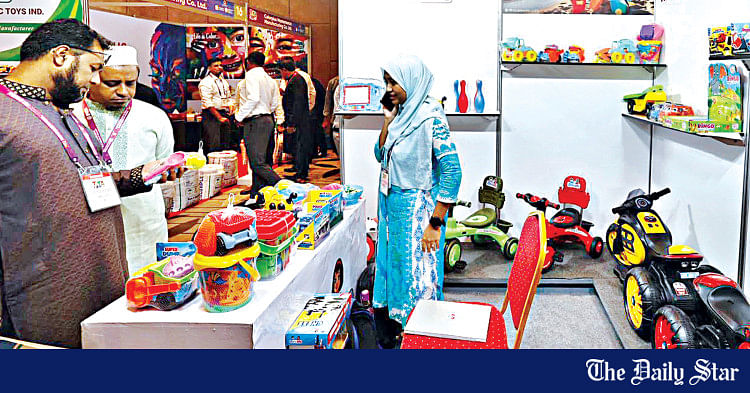Saif
Senior Member
- Jan 24, 2024
- 12,819
- 7,070
- Origin

- Residence

- Axis Group

Date of Event:
May 23, 2025
Bangladesh's toy story going global
SAJIBUR RAHMAN
Published :
May 23, 2025 00:31
Updated :
May 23, 2025 00:31

Bangladesh's toy industry is emerging fast as a promising export sector, showing consistent growth over the past few years.
In the fiscal year 2016-17, the country exported toys worth $15.23 million. By FY21, the figure rose to $36.5 million, with toys reaching 46 countries, including the United States, Russia, Japan, Germany, India, and China, according to Bangladesh Plastic Goods Manufacturers & Exporters Association (BPGMEA).
The momentum continued in FY22, with exports growing to $44.52 million. During this period, key export items included tricycles, scooters, pedal cars, and dolls, which were mainly shipped to Spain, Italy, France, Japan, the US, the UK, and Germany.
In FY23, exports surged to $77 million, with products going to about 88 countries.
"If the current average annual growth rate of around 24 per cent continues, projections suggest that toy exports from Bangladesh could hit $466.31 million by 2030, placing the country among the world's top 30 exporters," said BPGMEA President Shamim Ahmed.
This rapid growth is supported by a combination of government incentives, such as tax benefits and export subsidies, and the country's cost-effective, competitive labour force.
Bangladesh's strategic geographical position offers easy access to key regional markets, making it an attractive location for toy production and export, according to industry insiders.
Furthermore, the growing number of toy manufacturers, including small and medium enterprises (SMEs), has helped build local expertise in design and production, contributing to the sector's steady rise, they said.
The BPGMEA president said as part of its strategic roadmap, Bangladesh is aiming to establish dedicated toy manufacturing clusters, reduce export lead times, and encourage technology transfer and automation through greenfield investments.
Collaborative ventures with international brands are also being promoted to raise product standards and tap into established global supply chains, he pointed out.
With continued investment, regulatory compliance, and branding of "Made in Bangladesh" toys, the sector is poised for significant expansion, transforming into a dynamic export-oriented industry within the broader plastic manufacturing landscape, according to Shamim.
Rabiul Alam, admin officer at Sonic Bangladesh, told The Financial Express his company is expanding rapidly, with three new factories under construction in Dinajpur.
"We export to at least 20 countries, including European Union (EU) nations, such as Spain, Italy, France, and so on," he said on Thursday while showcasing the company's products at a two-day fair at InterContinental Dhaka.
The expo, organised by BPGMEA, will conclude today. It serves as a showcasing and sourcing platform for Bangladesh's plastic toy industry.
SAJIBUR RAHMAN
Published :
May 23, 2025 00:31
Updated :
May 23, 2025 00:31
Bangladesh's toy industry is emerging fast as a promising export sector, showing consistent growth over the past few years.
In the fiscal year 2016-17, the country exported toys worth $15.23 million. By FY21, the figure rose to $36.5 million, with toys reaching 46 countries, including the United States, Russia, Japan, Germany, India, and China, according to Bangladesh Plastic Goods Manufacturers & Exporters Association (BPGMEA).
The momentum continued in FY22, with exports growing to $44.52 million. During this period, key export items included tricycles, scooters, pedal cars, and dolls, which were mainly shipped to Spain, Italy, France, Japan, the US, the UK, and Germany.
In FY23, exports surged to $77 million, with products going to about 88 countries.
"If the current average annual growth rate of around 24 per cent continues, projections suggest that toy exports from Bangladesh could hit $466.31 million by 2030, placing the country among the world's top 30 exporters," said BPGMEA President Shamim Ahmed.
This rapid growth is supported by a combination of government incentives, such as tax benefits and export subsidies, and the country's cost-effective, competitive labour force.
Bangladesh's strategic geographical position offers easy access to key regional markets, making it an attractive location for toy production and export, according to industry insiders.
Furthermore, the growing number of toy manufacturers, including small and medium enterprises (SMEs), has helped build local expertise in design and production, contributing to the sector's steady rise, they said.
The BPGMEA president said as part of its strategic roadmap, Bangladesh is aiming to establish dedicated toy manufacturing clusters, reduce export lead times, and encourage technology transfer and automation through greenfield investments.
Collaborative ventures with international brands are also being promoted to raise product standards and tap into established global supply chains, he pointed out.
With continued investment, regulatory compliance, and branding of "Made in Bangladesh" toys, the sector is poised for significant expansion, transforming into a dynamic export-oriented industry within the broader plastic manufacturing landscape, according to Shamim.
Rabiul Alam, admin officer at Sonic Bangladesh, told The Financial Express his company is expanding rapidly, with three new factories under construction in Dinajpur.
"We export to at least 20 countries, including European Union (EU) nations, such as Spain, Italy, France, and so on," he said on Thursday while showcasing the company's products at a two-day fair at InterContinental Dhaka.
The expo, organised by BPGMEA, will conclude today. It serves as a showcasing and sourcing platform for Bangladesh's plastic toy industry.
Shamim said Sonic Bangladesh, now the market leader, alone exports toys worth $43 million annually.
Other major exporters include Cupcake Exports, a subsidiary of the US-based Cupcake Group, specialising in soft toys, with exports of $2.5 million, RFL ($2.0 million), ACI Premio Plastic ($1.0 million), and Zihan Plastics ($1.0 million). Hashy Tiger Company also exports toys.
Shamim noted that only 1.0 to 3.0 per cent of Bangladesh's population belongs to the affluent class, which is why the domestic market for high-end toys is limited.
"Most toy manufacturers focus on products for the wider population, as the demand for sophisticated and premium toys is very low locally," he explained. "A section of high-end consumers usually purchases imported toys, which discourages local producers from investing in upscale product lines."
Local toy manufacturers are increasingly focusing on complying with international safety and quality standards. Exported toys meet a range of regulatory benchmarks, including ASTM F963 in the US, EN71 in Europe, and ISO 8124 internationally.
Compliance with chemical safety regulations, such as REACH (EU) and CPSIA (USA), is crucial for accessing global markets. Certification marks like the CE marking for Europe and CPSC compliance for the US are now standard among major exporters.
Green certifications and ISO 9001 for quality management are also gaining importance as global consumers demand more sustainable and eco-friendly products, according to sector insiders.
Production covers plastic, soft, wooden, and educational toys, with a growing emphasis on science, technology, engineering, and mathematics (STEM) learning kits, puzzles, tricycles, and plush objects.
These products not only entertain but also play a vital role in children's cognitive, social, and emotional development. Educational toys help build problem-solving skills, improve motor coordination, encourage imagination, and even support language and cultural understanding.
From rattles for infants to interactive robots and construction sets for older children, the variety in Bangladesh-made toys reflects both market demand and evolving global trends.













